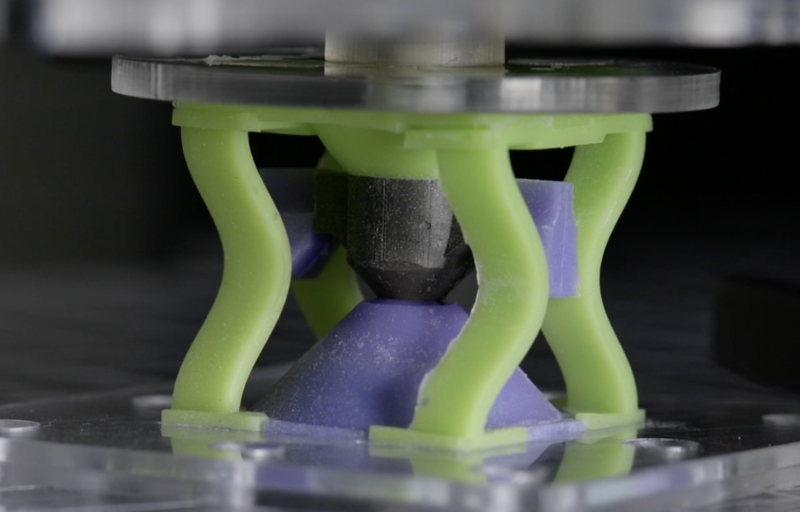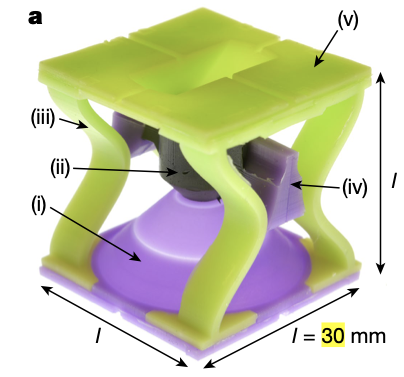
For applications like robotics, there's usually a clear division of labor between the processors that control the robot's body and the actuators that actually control the physical changes of that body. But a new paper being released today blurs the lines between the two, using a magnetic switch in a way that both stores a bit representing the hardware's state and alters the physical conformation of the hardware. In essence, it merges memory and physical changes.
This particular implementation doesn't seem to be especially useful—it's much too big to be a practical form of memory, and the physical changes are fairly limited. But the concept is intriguing, and it's possible that someone more adept at creative thinking can find ways of modifying the concept to create a useful device.
A magnetic metamaterial?
A metamaterial is generally defined as a material that is structured so that it has properties that aren't found in bulk mixes of its raw materials. A broad reading of that definition, however, would mean that a car is a metamaterial, which makes the definition near meaningless. The researchers behind the new device, based at Switzerland's École Polytechnique Fedeŕale de Lausanne, claim their creation is a metamaterial, but it's fairly large (roughly a cube three centimeters on a side) and has a number of distinct parts. I'd tend to call that a device rather than a material and will use that terminology here.
So what is the device? The part that changes its configuration is a platform supported by a set of four legs that are bent inward (v and iii in the image below). The two different states of the system are read out by registering the amount of force needed to push the platform down. The force needed is raised by pushing a wedge (iv) between the bend of the legs, forcing them outward and dropped again by sliding the wedge back out. The wedge is indirectly attached to a flexible base that pops between two stable states (i), a bit like the tops of twist-off jar lids that pop out to indicate the jar has been opened.

The whole thing is controlled by part ii, which links the flexible base to the wedges. In this device, it's made of a polymer that has had magnetic particles embedded in it. This allows the state of the device to be controlled using an external magnetic field. Pull the central magnetic component up and the base pops upward, driving the wedge between the legs and raising the force needed to deform the device. Push the magnetic hardware back down and the wedge drops out of the way, and the force required to push the platform down drops with it.
On the grid
The researchers built a six-by-six array of these devices and showed that the devices could be individually addressed using other magnetic devices positioned above and below it. The process isn't quick; it takes nearly a second for the device to change state, and the system has to cool down for four seconds after each of these. But the devices could be switched back and forth over 1,000 times without losing performance.
The six-by-six array allowed 37 different combinations of on/off states in individual devices, and the researchers tested the force required to flatten the platform in each of these states. As expected, that force varied based on the configuration, showing that the devices could collectively change the properties of the hardware they were part of.
But in addition to measuring the state of the devices via force, however, the researchers found they could also read their magnetic state, much like bits on a hard drive. Because of the change in the location of the magnetic part of the device, they found a five-fold difference in its magnetic properties when measured at the hardware's surface.
In total, the grid of devices enabled three distinct measurements to be made: an overall change in the deformation properties of the surface they supported, a difference in the force required to deform individual elements, and a change in the magnetic properties of individual elements.
Collectively, all of that is pretty neat. It's not, however, obviously useful. That's in part due to the device's size, but it's also in part because there's no obvious immediate need for a surface with fine-tuned compressibility or to read the state of the parts magnetically instead of simply remembering how they were set. But the researchers say that there should be a variety of means to shrink the device down. And they argue that the concept could be extended in a lot of ways now that it has been demonstrated. We'll have to reserve judgement on utility until we see what the rest of the research community does with the concept.
Nature, 2021. DOI: 10.1038/s41586-020-03123-5 (About DOIs).
reader comments
33